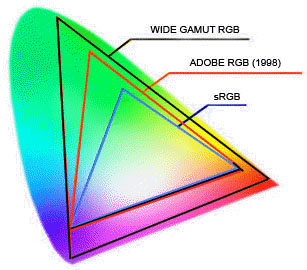 The capabilities and dynamic ranges of input devices such as cameras and scanners are different from those of output devices such as monitors and printers. The range of colours that can be reproduced by a device is known as its colour gamut. When an input device has a colour gamut that exceeds that of an output device, the colours that cannot be directly reproduced are compromised.
The capabilities and dynamic ranges of input devices such as cameras and scanners are different from those of output devices such as monitors and printers. The range of colours that can be reproduced by a device is known as its colour gamut. When an input device has a colour gamut that exceeds that of an output device, the colours that cannot be directly reproduced are compromised.
It can be seen from the diagram that the gamut of the grey-balanced Adobe RGB (1998) colour space is significantly larger than that defined by the sRGB space commonly used in scanners. Wide-gamut RGB clearly exceeds the capabilities of the other two colour spaces. An image taken from an sRGB scanner contains only colours within the blue triangle in the diagram. When transferred to a computer, and manipulated within the Adobe RGB (1998) colour space, some of the colours may spread out into previously unoccupied territory of the larger gamut.
Alternatively, if an image that used the Adobe RGB (1998) colour space is saved in sRGB format, all the colours which lie within the red triangle but outside the blue triangle must be changed. This may compromise the image.
It is important to note that coloured background area lying behind the gamut triangles represents the CIE chromaticity diagram which incorporates all the colours that a normal human eye is capable of perceiving. A principal problem with this sort of simplified gamut comparison is that colour is three dimensional and therefore cannot be properly represented in two dimensions. Colours which apparently lie within gamut in the two-dimensional diagram may therefore be found to be out of gamut when the models are viewed in three dimensions. The third dimension, not represented in the chromaticity diagram, is luminance. A three-dimensional representation of a range of RGB gamuts can be seen here.






